Fulmen
International Hazard
    
Posts: 1693
Registered: 24-9-2005
Member Is Offline
Mood: Bored
|
|
Making tracer rounds
I have decided I need some tracer rounds for 300BLK (subsonic), couldn't find any threads on this so here goes.
For those who wonder you can find cutaway images of most types of ammo here: http://www.ar15.com/ammo/project/Ammo_Cross_Sections/
Most of these rounds are 50% tracer comp, I don' think that is necessary for this project. My plan is to make tracer inserts from redrawn 22LR-cases,
say 4mm in diameter and 10mm long. These can then be inserted into any bullet I like. Bullets can be drilled out in a lathe using a suitable collet to
hold it without damage.
Pressing the comp (and drawing the cases) can be done in a standard reloading press.
I'm leaning towards green comp, for two reasons. The eye is most sensitive to green, so this should compensate for the reduced charge. Besides, green
just looks great :-)
The old PFP has some tracer comps:
http://www.privatedata.com/byb/pyro/pfp/tracers.html
From what I can tell the simplest are pretty basic star compositions, so it shouldn't pe a problem to formulate one from the chems I have available.
This could be the perfect time to test the barium perchlorate I have had lying about for 20 years, but I think I'll start with more conventional (and
non-hygroscopic) comps first.
The first green from Ellern seems like a good place to start. I'll probably substitute the magnesium with magnalium and the HCB with parlon.
I don't know what burn rate one can expect from these comps, I don't I'll be needing more than 1-2seconds of burn (300-600m range), guess I'll just
have to test some to see.
I also need to look at a decent prime. I don't feel like messing with graduated primes, so I need something hot and fast burning. I think I have some
powdered silicon that could come in handy for this.
Any other good suggestions?
Edit: Here's the basic design. A brass case with tracer comp, primer and a paper (?) disc to seal it off.
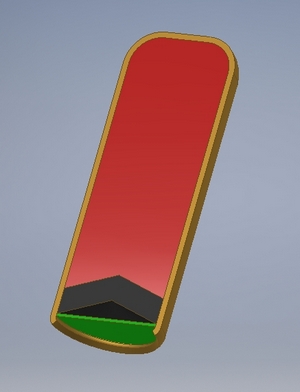
[Edited on 16-3-17 by Fulmen]
We're not banging rocks together here. We know how to put a man back together.
|
|
|
NedsHead
Hazard to Others
  
Posts: 409
Registered: 9-12-2014
Location: South Australia
Member Is Offline
Mood: No Mood
|
|
I plan on making some tracer rounds someday too, next time I have some disposable cash I'll buy the Strontium/barium nitrate needed to make them that
j_sum1 linked me to (thanks again Jay)
I think you're over engineering things by trying to use a spent .22 case to hold the tracer and igniter composition, drilling a small pocket in the
back of the 300BLC will suffice.
You'll also need a hydraulic press to pack the composition into the round and a die to keep the bullet from deforming, I doubt a reloading press can
match the chamber pressures (+10% or so) needed to keep the composition held together in the base of the bullet under firing, I built a small shop
press for doing this (and pressing my homemade black powder) a couple of weeks ago
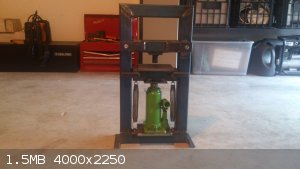
I have some further stuff to add but I'm short on time right now,
I'll come back to this thread later
|
|
|
greenlight
National Hazard
   
Posts: 705
Registered: 3-11-2014
Member Is Offline
Mood: Energetic
|
|
I agree with Nedshead, surely setting up a drill press and die to hold the bullet to drill out a portion of the back for the tracer comp would be
easier. Much the same design as is shown in the picture attached of the 9mm tracer round.
I found a document that explains in detail how to make a drill press setup, find the right pressure and mix up the tracer composition as well. I had
a quick read and it sounds reliable:
https://archive.org/stream/firearms-avellone-ted---how-to-ma...
It lists the green tracer composition as:
Barium nitrate 60
Hexachloroethane 20
Powdered shellac 10
100 mesh magnesium 30
And the ignition composition as:
Barium peroxide 81
Powdered shellac 25
325 mesh Magnesium 2
Good luck and keep us updated
[Edited on 17-3-2017 by greenlight]
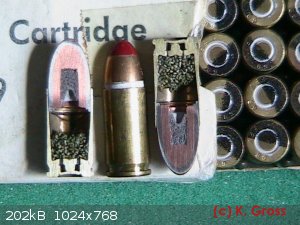
The only use for an atomic bomb is to keep somebody else from using one.
George Wald
|
|
|
Fulmen
International Hazard
    
Posts: 1693
Registered: 24-9-2005
Member Is Offline
Mood: Bored
|
|
There is no such thing as over engineering ;-)
I already have most of the tooling for drawing the cases, so that's not a major hassle. Besides, it simplifies the pressing part. Your solution will
require a custom die for every bullet you want to work with.
I agree that the comp should be pressed to appr working pressure, but a reloading press should still suffice. 4mm @ 400MPa is only 500kg.
We're not banging rocks together here. We know how to put a man back together.
|
|
|
Fulmen
International Hazard
    
Posts: 1693
Registered: 24-9-2005
Member Is Offline
Mood: Bored
|
|
I think Kyle Kepley's emerald green looks like a good place to start:
Potassium perchlorate - 8
Barium nitrate - 50
Magnalium (50/50), 200 mesh - 12
Airfloat - 5
Sulfur - 5
Parlon - 18
Red gum - 2
Dextrin - 5
Now these will be pressed dry, but I'm assuming both the sulfur and red gum will work as a binder. Or should I look for another fuel/binder?
I have some left-over tooling from a jacket-maker project, drawing .224 jackets from 22LR-cases. This should work fine for testing the concept. I'll
probably test them in a .38 or 9mm handgun for simplicity.
We're not banging rocks together here. We know how to put a man back together.
|
|
|
Fulmen
International Hazard
    
Posts: 1693
Registered: 24-9-2005
Member Is Offline
Mood: Bored
|
|
I have to admit I'm a bit apprehensive about pressing metal fueled compositions. If it must be pressed to appr peak pressure (400MPa) I will need both
a steel die and plunger, which does increase the risk if the charge ignites. Perhaps it's safer to start with a solvent-activated binder? Both saran
and parlon should dissolve in MEK, so that's probably the the best place to start.
However, this approach does have it's drawbacks. MEK is quite volatile, and with the amounts I'll be handling I fear evaporation can affect
consistency. Perhaps one could compact the powder into the insert while dry, then add a drop of solvent?
We're not banging rocks together here. We know how to put a man back together.
|
|
|
markx
National Hazard
   
Posts: 645
Registered: 7-8-2003
Location: Northern kingdom
Member Is Offline
Mood: Very Jolly
|
|
That method definitely works to cement the composition in place without the application of excessive forces, although it probably will not do so
uniformly throughout the whole section of the composition. But perhaps it will suffice to just create a hardened "plug" on the surface. Another aspect
that has to be accounted for is that the solvent will somewhat alter the distribution of binder (or rather all the components of the composition that
are soluble in that particular solvent) in the affected volume....a "chromatographic effect" if you will. This will cause some components to
concentrate on the surface or migrate away from it, which in turn may seriously affect the ignitability. I fear that achieving a sufficient
sensitivity towards ignition might prove the hardest part of the project.....having experimented a lot with similar situations in pyrotechical field I
can say that the propagation of ignition between different stages of a device can be quite tricky to master and even "obviously failsafe" combinations
tend to consistantly fail by even the minutest unfavorable alterations applied to assembly or manufacturing procedures.
Exact science is a figment of imagination.......
|
|
|
Fulmen
International Hazard
    
Posts: 1693
Registered: 24-9-2005
Member Is Offline
Mood: Bored
|
|
You bring up some excellent points there, Markx. Solvents could require some trial&error, but at least it's safe.
As for ignition I suspect you're right, it will probably be the hardest part. The few tracer primes I've seen has been peroxide-based, but that isn't
something I have access to.
We're not banging rocks together here. We know how to put a man back together.
|
|
|
NedsHead
Hazard to Others
  
Posts: 409
Registered: 9-12-2014
Location: South Australia
Member Is Offline
Mood: No Mood
|
|
I wasn't able to find strontium or barium peroxide either so I settled on synthesising calcium peroxide for the igniter composition,
http://www.prepchem.com/synthesis-of-calcium-peroxide/
my yields weren't great (about half the expected) but that would be due to my impure calcium chloride, my old and degraded hydrogen peroxide and my
cleaning grade ammonia, I didn't even get a precipitate at first, it wasn't until I added an additional 10-20ml ammonia and the calcium peroxide
crashed out of solution
I did some tests by mixing the calcium peroxide with 45 micron aluminium powder and got a pretty impressive thermite reaction, I think it will ignite
a tracer round.
I might take a video of the calcium peroxide/aluminium thermite tonight and upload it on YouTube
|
|
|
greenlight
National Hazard
   
Posts: 705
Registered: 3-11-2014
Member Is Offline
Mood: Energetic
|
|
I just had a look through some more tracer compositions and the strontium/barium peroxide comes up for all of them as a component.
I have seen strontium peroxide on ebay for decent price but he doesn't send overseas.
The composition listed above for green tracer contains sulfur in it. Would this not promote faster corrosion of the barrel than other compositions?
Considering that sulfur is the prime cause of this in older black powder firearms.
The only use for an atomic bomb is to keep somebody else from using one.
George Wald
|
|
|
NedsHead
Hazard to Others
  
Posts: 409
Registered: 9-12-2014
Location: South Australia
Member Is Offline
Mood: No Mood
|
|
Where's Bert when you need him?
|
|
|
Fulmen
International Hazard
    
Posts: 1693
Registered: 24-9-2005
Member Is Offline
Mood: Bored
|
|
Greenlight: Excellent point. Sulfides can be quite corrosive, so unless it's covered by a delay/igniter that prevents ignition in the barrel sulfur
should probably not be used.
BTW, if you look through the link I posted you'll find a number of non-peroxide compositions. Haven't found any sources comparing the performance yet
though.
Neadshead: Calcium peroxide sounds like a reasonably simple synthesis, so that might be an option. Silicon based primes are also efficient, but I
don't like getting silicon oxide in the barrel.
We're not banging rocks together here. We know how to put a man back together.
|
|
|
Fulmen
International Hazard
    
Posts: 1693
Registered: 24-9-2005
Member Is Offline
Mood: Bored
|
|
I'm considering making barium peroxide for this project. I don't really like to work with barium unless I have to, but the synthesis is pretty simple
and can be used to make hydrogen peroxide as well so it's a useful synthesis.
From what I can tell it's done by oxidizing BaO in dry air at 450-500°C, shouldn't be too hard to pull off.
We're not banging rocks together here. We know how to put a man back together.
|
|
|
NedsHead
Hazard to Others
  
Posts: 409
Registered: 9-12-2014
Location: South Australia
Member Is Offline
Mood: No Mood
|
|
Quote: Originally posted by Fulmen  | I'm considering making barium peroxide for this project. I don't really like to work with barium unless I have to, but the synthesis is pretty simple
and can be used to make hydrogen peroxide as well so it's a useful synthesis.
From what I can tell it's done by oxidizing BaO in dry air at 450-500°C, shouldn't be too hard to pull off. |
Just wondering if you even made any advancements with this project Fulmen?
It's been a long time but I've finally returned to finish what we started.
So far I've got the press, I've fitted a pressure gauge to a bottle jack, I've made a bullet die for Speer 180gn hot-cor projectiles and I have a nice
green pyrotechnic composition.
The last piece of the puzzle is a reliable igniter that I've not had any success with yet,
my calcium peroxide synths are hit and miss, so I'm looking for other suggestions,
Is it true that barium peroxide can be made relatively easily from barium nitrate and hydrogen peroxide in solution? I have both so I'll start there,
I also have the chems to make lead nitrato-hypophosphite, it's being used to re-prime spent primers although I would leave out the sensitiser (ground
glass) from the mix, but I'm not sure about using this one, It'll be challenging to work with at these pressures and form it situ.
|
|
|
Fulmen
International Hazard
    
Posts: 1693
Registered: 24-9-2005
Member Is Offline
Mood: Bored
|
|
Nah, I've pretty much shelved shooting as a hobby so the need disappeared.
We're not banging rocks together here. We know how to put a man back together.
|
|
|
Herr Haber
International Hazard
    
Posts: 1236
Registered: 29-1-2016
Member Is Offline
Mood: No Mood
|
|
Igniter ?
After pressing your composition add a layer of either:
BKNO3 / ZPP or plain KClO4 + Si
then seal in place with a binder such as a drop of NC laquer. If you try different igniters and have a high speed camera I'd love to compare the
muzzle flashes 
Very curious about the composition containing HC mentioned up there. That would make it smoke and tracer I assume. A composition for a spotting round
maybe ?
I'm no shooter but have been gathering an extensive collection of projectiles and brass. It's easy to differentiate a .50 ball from tracer just by
looking at the shape of the tail. Weighting the bullets makes it even more obvious. Also, the tracer section is much much smaller taking size into
consideration than the 9mm or .45 pictured up there. You can probably tweak your compositions taking into account the maximum flight time.
The spirit of adventure was upon me. Having nitric acid and copper, I had only to learn what the words 'act upon' meant. - Ira Remsen
|
|
|
NedsHead
Hazard to Others
  
Posts: 409
Registered: 9-12-2014
Location: South Australia
Member Is Offline
Mood: No Mood
|
|
Here are some pictures of my setup.
This is the whole setup with the press and die
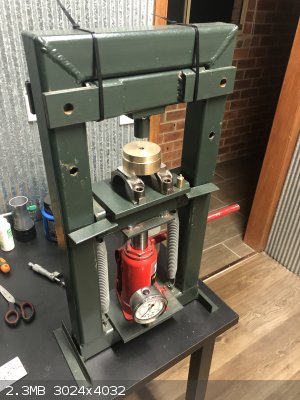
this is the projectile die I made to hold and not deform the projectile when under pressure, this round requires the pyrotechnic composition to be
pressed to 53,000 psi.
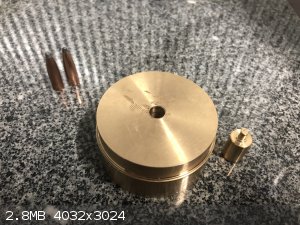
A finished tracer in the die
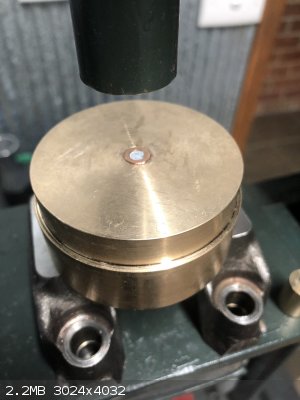
And out of the die
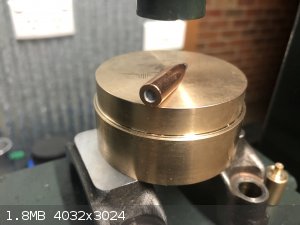
And lastly, here is a shot of the pressure gauge I fitted to the hydraulic bottle jack
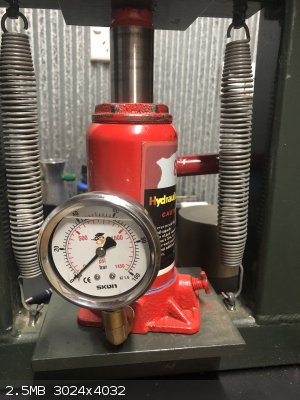
|
|
|
Rainwater
National Hazard
   
Posts: 799
Registered: 22-12-2021
Member Is Offline
Mood: indisposition to activity
|
|
I want that press so bad I can smell it. The gauge sets it off. Sweet build
"You can't do that" - challenge accepted
|
|
|
NedsHead
Hazard to Others
  
Posts: 409
Registered: 9-12-2014
Location: South Australia
Member Is Offline
Mood: No Mood
|
|
Thanks,
The total build didn't cost much, approx $65 AUD without the steel, I already had offcuts laying around.
if you're in the states you could do it even cheaper and I think you can buy bottle jacks already fitted with pressure gauges for a reasonable price
there, that's not the case here in Australia so I did it myself.
|
|
|
Fantasma4500
International Hazard
    
Posts: 1677
Registered: 12-12-2012
Location: Dysrope (aka europe)
Member Is Offline
Mood: dangerously practical
|
|
really nice simple build
i made one myself composed of 10x50mm flat iron where i drilled 20mm holes spaced- 50mm apart?
a 20mm threaded rod then goes through the holes, comes through a 20mm nut that i drilled 20mm holes in, connecting to 2 pieces of flat steel that fits
inside of the 2 pieces of flatsteel that are welded to a plate bottom
the springs are a nice detail, you can get far with just a few tonnes of pressure, can also be used to press chemicals into pellets to control
reaction speed
strobe composition pressed into a bullet, when? that would be very neat. the doppler effect would be very interesting on its own
|
|
|
NedsHead
Hazard to Others
  
Posts: 409
Registered: 9-12-2014
Location: South Australia
Member Is Offline
Mood: No Mood
|
|
I went out testing tonight, 5 batches at varying pressures above and below nominal, nominal being chamber pressure + 10% (53,000psi)
The test firearm is a Tikka T3 30-06
projectiles are Speer 180gn Hot-Cor, after drilling and packing with tracer and igniter composition they weigh in at 165gn
Propellant is 52gn ADI AR2209
Unfortunately none ignited, I suspect my tracer load pressures are too high, or maybe just the igniter pressure is too high and can be backed off.
The igniter composition I tested is 72g calcium peroxide, 24g magnesium, 1% shellac binder.
The igniter mix reacts well to an open flame when in a loose pile.
I'll load the next batch at half chamber pressure and see what happens, and I'll make a convex shaped pressing tool to increase surface area of the
igniter.
I'll try again next weekend and report back.
|
|
|